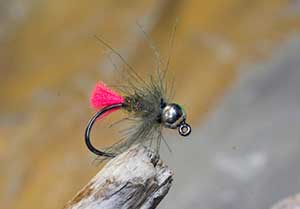CDC Red TagAndy LarkinTranslated by Carl Wuebben
THE JIG IS UP - Not everyone participates in or supports competitive fly fishing. But no matter where you stand; Gear, Presentation techniques or Flies have all been influenced by competitions. Flies tied using slotted beads and up eye jig hooks offer a number of advantages. From a practical perspective jig nymphs ride hook point up, reducing the risk of snagging and fouling a good characteristic for any nymph tumbling through infested reaches of a river bottom where trout prefer to reside. Another benefit of a jig nymph is that the majority of your fish will be solidly hooked in the upper lip. Fish hooked in the upper lip have a hard time throwing the fly they also provide a subtle jigging action helping suggest life and convincing the fussiest of fish that they are worth at least a sample nibble. The vast majority of jig nymphs are simple flies tied in the round. Flies tied in the round offer fish the same view of the fly no matter its orientation in the current as there are no wing cases or other features to suggest whether a fly is upright in the water or not.
PATTERN
HOOK – HANAK competition H450BL, #12 -#16 or DAIICHI 4640 or 4670 up eye jig hook #12 - #16
BEAD – Slotted tungsten silver or metallic pink tungsten
THREAD – Black 8/0 (70 denier) can use 6/0 (140 denier)
TAIL – Daytum Globrite Floss #4 (fire orange)
RIB – Red wire
BODY- Arizona synthetic peacock, Bronze peacock spectra dub #45 or peacock dyed red COLLAR – Natural CDC
HOW TO TIE
- Slide a slotted tungsten bead (small round opening first) onto the hook. Place in the vice and slide the bead forward up against the hook eye. Twist the bead as necessary so the slotted portion of the bead navigates around the angled shank so the bead pushes tight against the hook eye. Tie thread on behind the bead. Build a thread ramp behind the bead to lock it into place then cover the rest of the hook shank with thread. You should finish with your thread just behind the bead.
- Cut an 8 to 10 inch length of Globrite floss from the spool. Align the ends together. Double the floss over itself a number of times so it forms a small bow tie. Now tie the floss bow in just a little bit from the bead and there are equal amounts of floss on each side of the tie in point.
- Fold the forward floss rearward over the back half to form the tail. Secure the folded floss back down the shank to the bend of the hook with the thread. This will ensure a smooth and even underbody. Trim the floss even with the hook bend to form a short stubby tail. Your thread should now be behind the bead.
- Tie in the wire rib just behind the bead and secure it back along the near side of the shank to the base of the tail (wire should be hanging out over the tail).
- Form a neat slender tapered body from the base of the tail to the rear of the bead. Twist some Arizona synthetic peacock dubbing onto the thread by twisting it between your thumb and index finger real tight to form a noodle then wrap it forward and end it up against the bead (don’t forget your tapered body shape). Now tie it off. Spiral wrap the wire rib forward over the body using even open turns. Tie it off behind the bead then using a pulling and twisting motion (helicoptering) to break away the wire tag end.
- Using a magic tool or a bull clip fold a single CDC plume into it. Now you can use a dubbing loop or split the thread to make the collar.
Dubbing loop – Pull about 3-4 inches of thread out and insert you’re dubbing tool then bring the thread back up to the body and wrap onto the fly behind the bead then insert the CDC fibers and twist the tool to make the collar rope.
Split the thread – Flatten the tying thread by twisting the thread counterclockwise when looking from above. Using a dubbing or sewing needle carefully split the tying thread. Insert your finger into the split thread loop to keep it open then place the folded CDC plume into the split thread loop then remove your finger to trap the CDC in the loop. Twist the thread tight by spinning the bobbin clockwise which locks the CDC in place.- Wind the dubbed CDC directly behind the bead. Stroke the CDC fibers back after each wrap. The finished CDC hackle should be sparse and flow back over the body. Pinch off or trim any errant CDC fibers. Apply head cement or brushable superglue to roughly 1/2” of tying thread and wind the coated thread directly behind the bead. Whip finish to complete the fly then clip your thread off.
TIE UP A DOZEN OR TWO – AND GO FISHING*** But remember to practice C.P.R. (CATCH – PICTURE – RELEASE)


